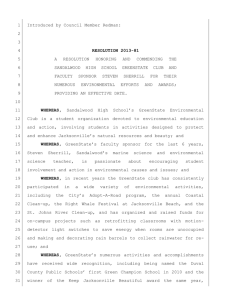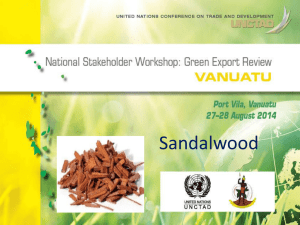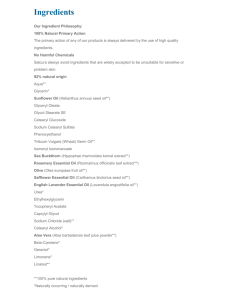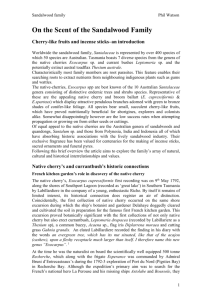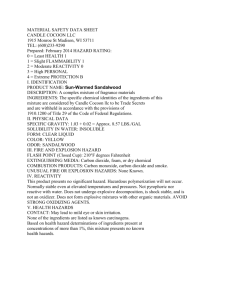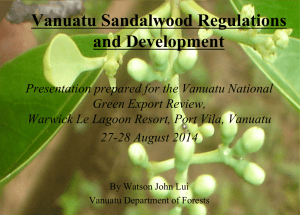Sandalwood—the Myth
advertisement
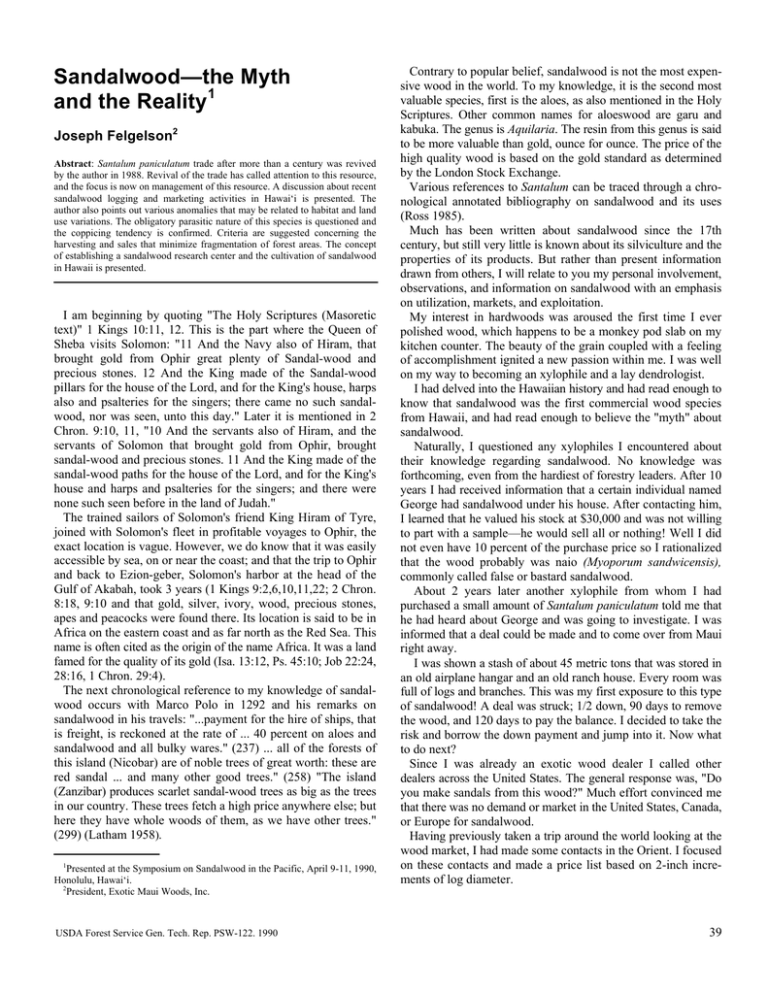
Sandalwood—the Myth and the Reality1 Joseph Felgelson2 Abstract: Santalum paniculatum trade after more than a century was revived by the author in 1988. Revival of the trade has called attention to this resource, and the focus is now on management of this resource. A discussion about recent sandalwood logging and marketing activities in Hawai‘i is presented. The author also points out various anomalies that may be related to habitat and land use variations. The obligatory parasitic nature of this species is questioned and the coppicing tendency is confirmed. Criteria are suggested concerning the harvesting and sales that minimize fragmentation of forest areas. The concept of establishing a sandalwood research center and the cultivation of sandalwood in Hawaii is presented. I am beginning by quoting "The Holy Scriptures (Masoretic text)" 1 Kings 10:11, 12. This is the part where the Queen of Sheba visits Solomon: "11 And the Navy also of Hiram, that brought gold from Ophir great plenty of Sandal-wood and precious stones. 12 And the King made of the Sandal-wood pillars for the house of the Lord, and for the King's house, harps also and psalteries for the singers; there came no such sandalwood, nor was seen, unto this day." Later it is mentioned in 2 Chron. 9:10, 11, "10 And the servants also of Hiram, and the servants of Solomon that brought gold from Ophir, brought sandal-wood and precious stones. 11 And the King made of the sandal-wood paths for the house of the Lord, and for the King's house and harps and psalteries for the singers; and there were none such seen before in the land of Judah." The trained sailors of Solomon's friend King Hiram of Tyre, joined with Solomon's fleet in profitable voyages to Ophir, the exact location is vague. However, we do know that it was easily accessible by sea, on or near the coast; and that the trip to Ophir and back to Ezion-geber, Solomon's harbor at the head of the Gulf of Akabah, took 3 years (1 Kings 9:2,6,10,11,22; 2 Chron. 8:18, 9:10 and that gold, silver, ivory, wood, precious stones, apes and peacocks were found there. Its location is said to be in Africa on the eastern coast and as far north as the Red Sea. This name is often cited as the origin of the name Africa. It was a land famed for the quality of its gold (Isa. 13:12, Ps. 45:10; Job 22:24, 28:16, 1 Chron. 29:4). The next chronological reference to my knowledge of sandalwood occurs with Marco Polo in 1292 and his remarks on sandalwood in his travels: "...payment for the hire of ships, that is freight, is reckoned at the rate of ... 40 percent on aloes and sandalwood and all bulky wares." (237) ... all of the forests of this island (Nicobar) are of noble trees of great worth: these are red sandal ... and many other good trees." (258) "The island (Zanzibar) produces scarlet sandal-wood trees as big as the trees in our country. These trees fetch a high price anywhere else; but here they have whole woods of them, as we have other trees." (299) (Latham 1958). 1 Presented at the Symposium on Sandalwood in the Pacific, April 9-11, 1990, Honolulu, Hawai‘i. 2 President, Exotic Maui Woods, Inc. USDA Forest Service Gen. Tech. Rep. PSW-122. 1990 Contrary to popular belief, sandalwood is not the most expensive wood in the world. To my knowledge, it is the second most valuable species, first is the aloes, as also mentioned in the Holy Scriptures. Other common names for aloeswood are garu and kabuka. The genus is Aquilaria. The resin from this genus is said to be more valuable than gold, ounce for ounce. The price of the high quality wood is based on the gold standard as determined by the London Stock Exchange. Various references to Santalum can be traced through a chronological annotated bibliography on sandalwood and its uses (Ross 1985). Much has been written about sandalwood since the 17th century, but still very little is known about its silviculture and the properties of its products. But rather than present information drawn from others, I will relate to you my personal involvement, observations, and information on sandalwood with an emphasis on utilization, markets, and exploitation. My interest in hardwoods was aroused the first time I ever polished wood, which happens to be a monkey pod slab on my kitchen counter. The beauty of the grain coupled with a feeling of accomplishment ignited a new passion within me. I was well on my way to becoming an xylophile and a lay dendrologist. I had delved into the Hawaiian history and had read enough to know that sandalwood was the first commercial wood species from Hawaii, and had read enough to believe the "myth" about sandalwood. Naturally, I questioned any xylophiles I encountered about their knowledge regarding sandalwood. No knowledge was forthcoming, even from the hardiest of forestry leaders. After 10 years I had received information that a certain individual named George had sandalwood under his house. After contacting him, I learned that he valued his stock at $30,000 and was not willing to part with a sample—he would sell all or nothing! Well I did not even have 10 percent of the purchase price so I rationalized that the wood probably was naio (Myoporum sandwicensis), commonly called false or bastard sandalwood. About 2 years later another xylophile from whom I had purchased a small amount of Santalum paniculatum told me that he had heard about George and was going to investigate. I was informed that a deal could be made and to come over from Maui right away. I was shown a stash of about 45 metric tons that was stored in an old airplane hangar and an old ranch house. Every room was full of logs and branches. This was my first exposure to this type of sandalwood! A deal was struck; 1/2 down, 90 days to remove the wood, and 120 days to pay the balance. I decided to take the risk and borrow the down payment and jump into it. Now what to do next? Since I was already an exotic wood dealer I called other dealers across the United States. The general response was, "Do you make sandals from this wood?" Much effort convinced me that there was no demand or market in the United States, Canada, or Europe for sandalwood. Having previously taken a trip around the world looking at the wood market, I had made some contacts in the Orient. I focused on these contacts and made a price list based on 2-inch increments of log diameter. 39 I had a good bite from Taiwan requesting a2-ton sample order. A letter of credit was established that enabled me to move the wood to Maui. A further sample order from Japan requesting 6to 8-inch diameter logs enabled me to build a shed on my land to store all these logs, roots, and branches. I was informed that the origin of this wood was the Honomalino area of Hawai‘i, which was cleared for the planting of macadamia nuts 38 years ago. George told me that was all he could salvage, but that it was really sad how much sandalwood was bulldozed and burned. At the end of 1987 a Taiwanese buyer came over and offered close to $200,000 for my acquisition. We celebrated New Year's Eve together, and I was close to ecstatic at my apparent new-found fortune. All I had to do after signing purchase agreements was to wait for the letter of credit, which did not arrive. Chinese New Year was the excuse! Amazingly, on the first working day of 1988 I received a call from Hong Kong inquiring about the sandalwood. I informed them that a deal was already struck, but that if things did not work out I would get back to them. By this time I had reports back from Taiwan and Japan that there was too much sap on the logs, that the price was too high, and that the quality was not good enough. When the Hong Kong buyer arrived he carefully measured the heartwood diameters and log diameters. He explained to me that the only usable part of the wood is the fragrant heartwood and that that was all he wanted. Everywhere else in the world that is how the product is bought. Since all of the other sandalwood-producing countries have cheaper labor than Hawai‘i, it did not appear to make sense to desap the wood in Hawai‘i. Other places would desap in the field. Therefore, his offer to me was less than half of the previous offer. The Hong Kong buyer suggested that buying sandalwood was a highly specialized business. The reason that the previous offer by the Taiwanese buyer was not forthcoming was because it was speculative, opportunistic, not founded on reality, and because he obviously did not know what he was doing. After some calculations the new buyer determined that the quality was about 50 percent heartwood and 20 percent grade A 10-inch heartwood diameter and up. My final argument to try to up the price was that I could not believe that 50 percent of the volume in dead sapwood could weigh as much as 50 percent volume in heartwood. Well I was surprised! I selected a 36-inch log to clean. Needless to say I picked one with sap that looked more deteriorated than the average. The log was measured and determined mathematically to be 52 percent heartwood (using the formula pi R2 x L of the log minus pi R2 x L of the heartwood and divided by the volume of the log x 100 to give percentage of sapwood or, alternatively, heartwood volume divided by log volume x 100 to give heartwood percentage). A quick way to determine the percentage of heartwood would be to eliminate the length and pi factor since they are common to both sides of the equation and to use the simple formula of heartwood diameter2 divided by log diameter2 x 100 equals the heartwood percentage. The same causal relationship exists between R2 x D2. It was a new game: guesstimating the heartwood! After weighing and working for an hour cleaning the aforementioned log, I then reweighed it. To my surprise the log was 40 now 46 percent clean heartwood of original weight, thereby satisfying my impulse that sap should weigh less than heartwood. Well, I accepted his offer and got to thinking that during the harvest of the sandalwood by the Hawaiians, before 1845, they did not have good shoes, four-wheel drives, roads, and helicopters; and that to eliminate a species of any kind is a formidable task. Maybe it was time to investigate this pandora's box. By exploring the Honomalino area of Hawai‘i, I was able to identify the specie due to my new familiarity with the trunk and bark. I then realized that this species was abundant on the leeward coast of the Island of Hawai‘i. To encourage me to seek out more sandalwood the Hong Kong buyer provided me with a contract to procure more sandalwood. The price was based on a 50/50 heartwood/sap ratio, and the contract stated that I provide 20 percent grade A wood. I proposed a contract with one of the ranches on the leeward coast based on this contract with the Hong Kong buyer. The ranch elected not to sign but verbally agreed to go along. Well, at the end of our 2-week venture we were responsible for the deficit of not supplying the 20 percent grade A. Almost every tree that we cut on the ranch, which were not many, had rot in them (fig. 1). The largest tree we cut had a 34-inch log diameter on the butt, but it was rotten throughout. At this time a second ranch was willing to negotiate a contract. The Hong Kong buyer and I sat down to brainstorm a set of specifications for different price categories. We made a major mistake. Based on the knowledge of our previous dealing, we both assumed that sandalwood in Hawai‘i is naturally 50/50 ratio of sapwood to heartwood. We had written the specifications based on this faulty premise. By the time this contract came to maturity, naturally all that was recalled was the written word. The buyer was supposed to be present to help us get going because this was our first venture into cutting live sandalwood. During the course of this contract, the media became involved and articles appeared in the newspaper. The melodramatic ramblings of one of the writers was rather quaint, "...a convoy of trucks coming down the mountain under the shroud of darkness with their precious cargo laden for the Orient." At this point the deliveries were reaching their destination. There were problems: too much sapwood, and a new phenomenon—wood quality that was not sap and not heartwood. We called this pre-heart or false-heartwood. It was fiber that had not yet become heartwood, and it had no fragrance. The buyers asked us to stop cutting. At the same time the ranch told us to stop cutting. They had received a better offer for the sandalwood due to the media exposure. It was time to regroup—the buyers and sellers were unhappy and so were some constituents. The legislators called public hearings and the myth was exploded. Most people had been content to believe that sandalwood was virtually extinct. But they had no basis for being upset when we explained that it was plentiful, of commercial value, and that quantities were sufficient to export. It became a non-issue, as the logging was done on private land, and it stopped soon thereafter. Before the hearings the idea had been to protect the sandal- USDA Forest Service Gen. Tech. Rep. PSW-122. 1990 wood; thereafter the emphasis was to manage it. At that stage the buyers had lost a substantial amount of money due to excessive sapwood. We were liable to return the amount of money overpaid due to their overpayment against the grade A, which was not present. Due to our limited knowledge at the time, our approach was not streamlined to meet the demands of the buyer. Our approach was to take everything we considered commercially viable rather than to be selective. We had not considered methods of testing the trees and had no knowledge of horizontal increment borers. Anyway it would be more than a year until our next contract. We had collected seeds from our previous harvest, and we distributed these to various green thumbs. The germination rate was zero, but this I can attribute to improper handling and storage of the seeds. A fungus had grown all over them. Our next contract started on October 15, 1989, with one of the larger land holders on the leeward side of the island of Hawai‘i. This contract is valid for 1 year. At this time the principals are involved in legal disputes so I cannot comment any more in that regard. However, this area presents some interesting possibilities. The ecosystem has more or less been divided into two by a large a‘a flow. Along the northern flank there has been no evidence of cattle intrusion. Moreover the southern area has been cattle-free for at least 6 years. West of this property is sandal habitat still in cattle. Furthermore the property is also crossed by other a‘a and pahoehoe flows, thus creating various pockets referred to as kipukas. These kipukas vary in regard to the age of the trees in them. For example, in a kipuka that probably never had cattle, the habitat has a variety of tree ages, and these trees appear to have less rot and death prior to maturity. All of these areas have the invasive kikuya grass, banana poka, and lantana. Areas less grazed are definitely better sandalwood habitat. In the habitats that are currently grazed, there is no evidence of regrowth. In the areas that were grazed in the past, there is evidence to suggest high rot occurrence and premature deaths, and regrowth is no older than the time that the cattle have been out of the area. Approximately 2 years ago there was an unauthorized harvest in some of this area, and today there is clear evidence of reproduction by coppicing. Also on the adjoining southern property it has been reported by March Winkler at a Hawaii Forest Industries Association meeting held on February 23, 1990, of coppicing regrowth rates of 3 1/2 feet and the production of seeds after one half a year. A good way to distinguish different areas in the habitat is by using the U.S. Soil Survey maps. According to the soil type it is my observation that rMWD soil type (extremely stony a‘a muck with 6-20 percent slopes) is the preferred type, although it occurs in other types except the pahoehoe flows. I also feel that it is necessary to provide empiric verification of the supposed parasitic nature of the tree. There is possibly more evidence to suggest that the tree may not be parasitic at all, or possibly the tree is parasitic or maybe symbiotic only at certain times. I have noticed that older trees have roots that spread out on the soil surface. Many of these roots lead into live or dead mamani, but they then also seem to leave the mamani. After having dug Figure 1—Heartrot, which is a common problem, can greatly reduce the value of sandalwood. USDA Forest Service Gen. Tech. Rep. PSW-122. 1990 41 up the mamani and sandalwood interface it was impossible for me to determine its nature without supportive scientific investigation. Much of the regrowth of the sandalwood regenerates from these roots, especially if some kind of shock such as cutting occurs. Where one finds singular sandalwood trees without other tree species, only the tree and kikuya grass, or areas where the only tree type is the sandal, one would then ask if the tree is parasitic unto itself or the kikuya grass. Many trees have the kikuya grass growing up the center rot. Maybe the grass parasitizes the tree— at least it appears that way. Much of the sandalwood habitat was previously logged for the big koa, which in essence means the the understory of sandalwood is now exposed and furthermore that most of the habitat has been subjected to grazing at one time or another. I believe there could be a beneficial relationship between the koa and the sandalwood—certainly the trees would attain straighter and taller trunks—and the possibility for their compatibility as an agro-forestry crop needs to be investigated. Sandalwood seeds have a very hard shell. Possibly nature meant the seeds to be dispersed by birds, with the acid in their stomachs aiding in germination. In the latter-mentioned ranch area, there is some planting of eucalyptus, and—amazingly— there are young sandalwoods growing under the eucalyptus. I have theorized that turkeys have been feeding on seeds and then roosting in the trees at night, where they drop the seeds. We should pen some turkeys, feed them seeds, and then germinate the seeds. This may be more effective than scarification or other conventional seed treatments. In general I would say that the sandal wood tree prefers a variety of species for neighbors, the most common being koa (Acacia koa), mamani (Sophora chrysophylla), ohio (Metrosideros collina var. polymorpha), kopiko (Straussia kaduana), ahakea (Bobea Mannii), naio (Myoporum sandwicensis), lantana, and kikuya grass. Ultimately criteria will have to be laid forth concerning harvesting and sales that minimize fragmentation of forest areas, and a sustained-yield concept must be adopted. Separate owner parcels could treat the area as a total ecosystem, adopt sustained yield and sound management principles, and provide access for scientific study. In January 1989, I made a proposal outlining the concept of establishing a sandalwood research institute, and a proposal regarding the cultivation of sandalwood in Hawai‘i. Here are some excerpts: "Sandalwood has been of historical significance and of economic importance since it was first exported in 1778. As a result of both agricultural development and commercial harvesting, natural stands have become depleted. Interest has therefore developed in replenishing stocks of Sandalwood for marketing, focusing on attempts at re-establishing the species in natural environments. I have personally been pursuing knowledge about Sandalwood, which I would be willing to share with the State of Hawaii and Resource Management. I have contacted research centers in various countries, including India, Australia and Fiji. Much information concerning studies of the Sandalwood species has 42 come my way, including an invitation to visit various Sandalwood research centers and plantations. Also, an offer from a professor in India with 30 years experience in growing Sandalwood, for us to sponsor a visit to Hawaii where he would like to see our Sandalwood and he would be willing to share his knowledge with us. Since the rediscovery of Sandalwood in 1988, more than $1,000,000 has come into the State of Hawaii from this export. This would make Sandalwood the largest foreign export commodity for 1988 for the State of Hawaii. Since this genus is cultivated in other countries, it warrants the further studies necessary to determine the best methods and feasibility of cultivating Sandalwood as an agro-forestry crop within the State of Hawaii. Objective To establish a Sandalwood Research Institute that would: A) Determine the geographical areas of Hawaii that have Sandalwood occurrence. B) Determine the volume of inventory of Sandalwood in these areas. C) Undertake the study of the germination and establishment of Sandalwood for planting. D) Sandalwood Research Institute would after studying all published literature concerning all aspects involved for the propagation of Sandalwood undertake recommendations, field experiments establishing the viability of cultivating Sandalwood species. Reports would be published and methods for the successful propagation would be achieved. After the adoption of field tested propagation and planting techniques, Sandalwood can then be grown in large quantities and can be planted on State, Hawaiian Homelands and private lands. The overall research aims are: A) To determine the areas that naturally have Sandalwood and to access the inventory. B) To obtain scientific research of Sandalwood harvesting impacts and to develop a Sandalwood management plan. C) To establish research plots to determine the best method of germination by seed or coppice to ensure sustainability of the resource." The technology of satellite mapping can provide 90 percent accuracy for species identification and distribution. This can be a great help to focus more expensive timber cruising and aerial photographic work on smaller targeted areas. The flexibility of digital imagery is proving to be multipurpose, and can be used to assess forest fire danger, and to plan controlled burning strategies based on forest and land cover diversity. With the help of all my distinguished colleagues attending the Sandalwood Symposium and the Department of Land and Natural Resources, a joint effort to establish a sandalwood research organization would inevitably enhance the ecosystem. REFERENCES Latham, R.E., transl. 1958. Marco Polo: The Travels. Penguin Classics. Ross, M. S. 1985. An annotated bibliography of sandalwood and its uses. University of Oxford. Wageningen, the Netherlands: Foundation for Dutch Forestry Development Co-operation. USDA Forest Service Gen. Tech. Rep. PSW-122. 1990
